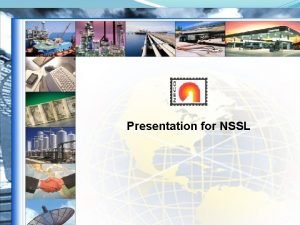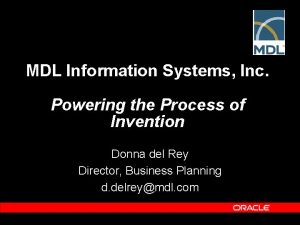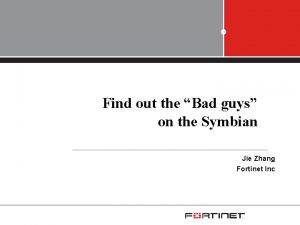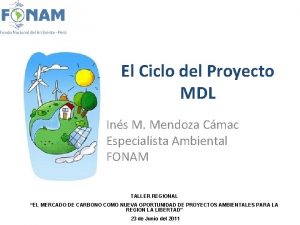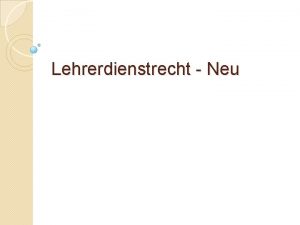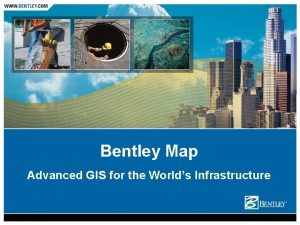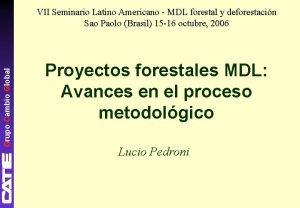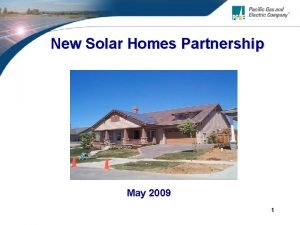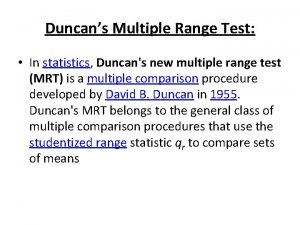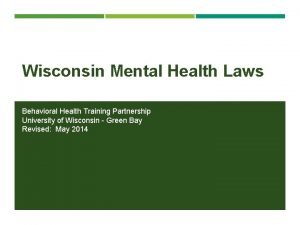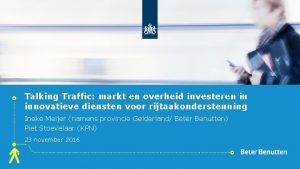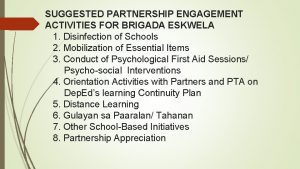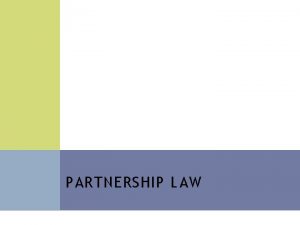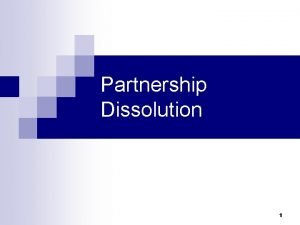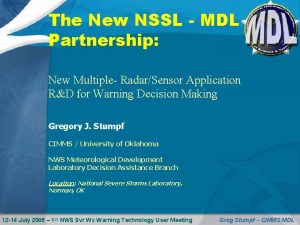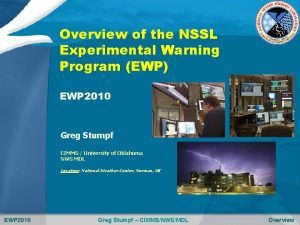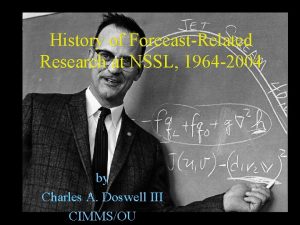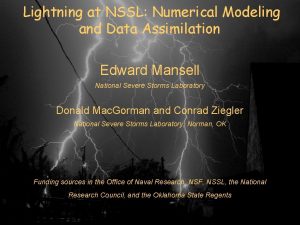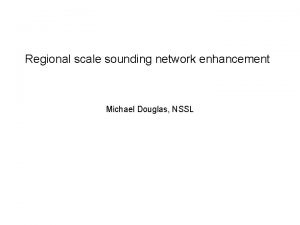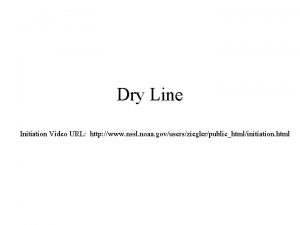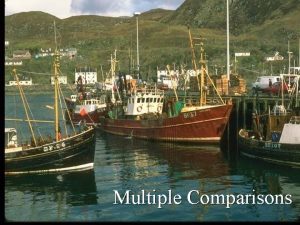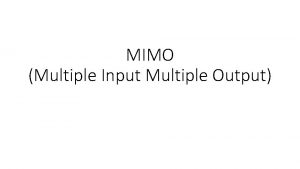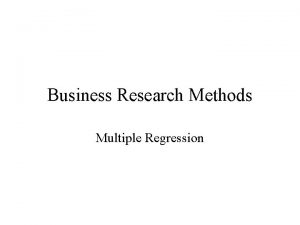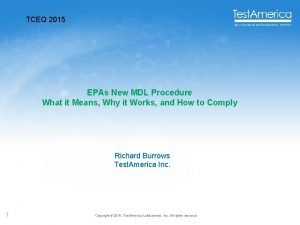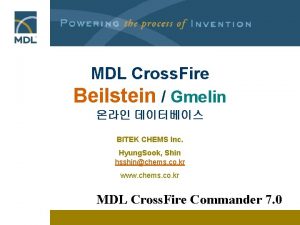The New NSSL MDL Partnership New Multiple RadarSensor
































































- Slides: 64

The New NSSL - MDL Partnership: New Multiple- Radar/Sensor Application R&D for Warning Decision Making Gregory J. Stumpf CIMMS / University of Oklahoma NWS Meteorological Development Laboratory Decision Assistance Branch Location: National Severe Storms Laboratory, Norman, OK 12 -14 July 2005 – 1 st NWS Svr Wx Warning Technology User Meeting Greg Stumpf – CIMMS/MDL

NSSL’s Vision in 2003 for NWS Warning Improvement Support NWS Science and Technology Infusion Plan NSSL pitching idea to NWS to make WDSSII a Multi-Sensor Products Generator for AWIPS (to supplement ORPG) u ORPG only produces single-radar products Warning test beds (at least one per region) using WDSSII to feed products to AWIPS Introduce 4 D radar analysis concepts as an AWIPS “pop-up” option NWS Warning Decision Making “team” interaction; training Motivate WDM team to aid with the design phase of new warning applications and display concepts Include WDSSII into WDTB Advanced Warning Operations Course as a high-resolution 4 D radar base-data analysis tool 12 -14 July 2005 – 1 st NWS Svr Wx Warning Technology User Meeting Greg Stumpf – CIMMS/MDL

The First Step My NSSL position was moved into the NWS Meteorological Development Laboratory Decision Assistance Branch My new boss: Dr. Stephan Smith My location remained at NSSL in Norman Act as a liaison between severe weather research and application development at NSSL and NWS warning operations program Develop AWIPS testbed for new remote-sensing technologies and new multiple-sensor warning applications 12 -14 July 2005 – 1 st NWS Svr Wx Warning Technology User Meeting Greg Stumpf – CIMMS/MDL

NSSL’s Mission To enhance NOAA’s capabilities to provide accurate and timely forecasts and warnings of hazardous weather events. NSSL accomplishes this mission, in partnership with the National Weather Service (NWS), through a balanced program of research to advance the understanding of weather processes research to improve forecasting and warning techniques development of operational applications and transfer of understanding, techniques, and applications to the NWS. NSSL is the sole NOAA agency responsible for the R&D of new applications and technology to improve NWS severe weather warning decision making. 12 -14 July 2005 – 1 st NWS Svr Wx Warning Technology User Meeting Greg Stumpf – CIMMS/MDL

Needs Assessment 12 -14 July 2005 – 1 st NWS Svr Wx Warning Technology User Meeting Greg Stumpf – CIMMS/MDL

Needs Assessment More frequent algorithm updates (not at end of volume scan) Intermediate products (help to understand final output, understand science, build expertise) Better data QC (to remove false alarms outside storms) Multi-radar integration (cones-of-silence, far ranges, terrain blockage) NSE integration (automated, more frequent updates, better spatial resolution, for HDA, SCIT-RU, multi-radar integration). 12 -14 July 2005 – 1 st NWS Svr Wx Warning Technology User Meeting Greg Stumpf – CIMMS/MDL

The NWS Severe Weather Warning Challenge How do operational warning forecasters distinguish between severe and non-severe, and tornadic and non-tornadic thunderstorms with the information they have? 12 -14 July 2005 – 1 st NWS Svr Wx Warning Technology User Meeting Greg Stumpf – CIMMS/MDL

The NWS Severe Weather Warning Challenge To reduce the uncertainty and improve the accuracy of a prediction, a warning forecaster will integrate more information about a storm as viewed by other radars and other sensors: Multiple radar data (WSR-88 D, TDWR) Near-Storm Environment (NSE) Surface observations Upper Air data Lightning data Satellite data Algorithm guidance Trends Spotter reports Statistical knowledge of past events Basic understanding of storm physics 12 -14 July 2005 – 1 st NWS Svr Wx Warning Technology User Meeting Greg Stumpf – CIMMS/MDL

Severe Weather Warning Decision Making Applications It makes sense that the NWS severe weather detection, diagnosis, and prediction tools also integrate multiple-sensor information! “Multiple-sensor” integration is not a new concept However, the MS concept has yet to be fully realized within NWS warning applications (still mostly singleradar based) 12 -14 July 2005 – 1 st NWS Svr Wx Warning Technology User Meeting Greg Stumpf – CIMMS/MDL

New Severe Weather Algorithm Requirements Objectives for new warning application development: Integrate multiple-radar and multiple-sensor information u u u No longer single-radar specific Must input highest resolution data in native format More accuracy in detection and diagnosis (oversampling - more “eyes” looking at storms). Must have rapid-update capability u u Uses virtual volume scan concept Better lead time (no more waiting until end of volume scan for guidance). Must be scientifically sound 12 -14 July 2005 – 1 st NWS Svr Wx Warning Technology User Meeting Greg Stumpf – CIMMS/MDL

Legacy WSR-88 D Severe Weather Applications ORPG Algorithms: SCIT, HDA, TDA, MDA, etc. Signature detection based on single-radar data. Disadvantages of single-radar algorithms: Products generated at end of volume scan Only 5 -6 minute updates – storm evolution is fast Poor sampling within cone-of-silence and at far ranges Products all keyed to individual radar volume scan and radar domain (azimuth/range/elevation) No automated tuning for different near-storm environments 12 -14 July 2005 – 1 st NWS Svr Wx Warning Technology User Meeting Greg Stumpf – CIMMS/MDL

Many single radars provide many different answers VIL = 34 KJAN VIL = 52 KLIX VIL = 45 KMOB 12 -14 July 2005 – 1 st NWS Svr Wx Warning Technology User Meeting Greg Stumpf – CIMMS/MDL

Many single radars provide many different answers The “best” detection? VIL = 52 KLIX 12 -14 July 2005 – 1 st NWS Svr Wx Warning Technology User Meeting Greg Stumpf – CIMMS/MDL

Multiple Radar Algorithms Storms are oversampled, especially in cones-of-silence and at far ranges from single radars. Outputs information in rapid intervals; can be as fast as individual elevation scan updates using “virtual volume scans”. “Rapid update” also works in single-radar mode if coverage or outages dictate. Multiple radars and rapid update lead to more stable tracks and trends Products keyed to 4 D earth-relative coordinate system (lat, lon, elevation, time). Designed to be VCP independent, and can be integrated with other “gapfilling” radar platforms (TDWR, ASR, PAR, SMART-R, NETRAD/CASA, foreign radars, commercial radars). 12 -14 July 2005 – 1 st NWS Svr Wx Warning Technology User Meeting Greg Stumpf – CIMMS/MDL

Multiple radars provide one answer KJAN KLIX KMOB 12 -14 July 2005 – 1 st NWS Svr Wx Warning Technology User Meeting Greg Stumpf – CIMMS/MDL

3 D Multiple-radar grid applications Mosaic multiple radar data to create a 3 D Cartesian lat/lon/ht grid. Uses time-weighting and power-density (distance) weighting schemes. Intelligently handles terrain blockage, interpolation in sparse grid cells Can advect older data when running a motion estimator. Run algorithms on continuously-updating 3 D grids (“virtual volumes”) – the data are nearly LIVE: 3 D reflectivity field for Max. Ref, VIL, echo top, LRM, LRA, hail, Cell ID 3 D velocity derivative fields for vortex (rotation) and wind shift (convergence) detection. Easy to integrate other sensor information (NSE, satellite, lightning, etc. ) on similar grids. e. g. , Thermodynamic info for hail diagnosis. 12 -14 July 2005 – 1 st NWS Svr Wx Warning Technology User Meeting Greg Stumpf – CIMMS/MDL

Multiple-Radar 3 D Reflectivity Mosaic 12 -14 July 2005 – 1 st NWS Svr Wx Warning Technology User Meeting Greg Stumpf – CIMMS/MDL

Multiple-Radar 3 D Merging 3 D Grid information: Create a 3 D Lat-Lon-Height grid of 3 D “voxels” Current resolution: 0. 01 x 1 km Current domain: covers the entire CWAs of OUN, FTW, and TSA, plus a “buffer” Radars: Level-II data from KTLX, KINX, KSRX, KVNX, KICT, KDDC, KAMA, KLBB, KFDR, KFWS, KDYX (later: KGRK, and even later: CONUS!) Each 3 D grid voxel “knows” which radars are sensing it (this info is cached) If terrain blocks a radar’s view of a voxel, that radar is not used for that voxel Latest elevation scan of data from any radar is used, replacing the previous version (“virtual volumes”). 12 -14 July 2005 – 1 st NWS Svr Wx Warning Technology User Meeting Greg Stumpf – CIMMS/MDL

Multiple-Radar 3 D Merging Data are QCed, to remove non-precipitation echoes (e. g. , AP) Older data are advected forward in time using a motion estimator Data are interpolated between elevation scans For each radar sensing a voxel, the radar info is weighted based on a power-density function (inversely proportional to distance). Internal 3 D grid is updating continuously, but new product grids are generated every 60 seconds (can be faster!). 12 -14 July 2005 – 1 st NWS Svr Wx Warning Technology User Meeting Greg Stumpf – CIMMS/MDL

Quality Control Neural Network (QCNN) Use multiple-sensor information to segregate precipitation echoes from non-precipitation echoes: Non-precipitating clear-air return Ground Clutter Anomalous Propagation (AP) Chaff Multiple Sensor Information (two stages): Radar (texture statistics from all three moments, vertical profiles) Radar, satellite, and surface temperature (“cloud cover”) Resulting clean “precipitation” field used as input to other applications (MDA, TDA, QPE, LLSD) MDA and TDA false alarms are going to be a major issue when radars sample clear air return with more resolution (new VCPs, TDWR). 12 -14 July 2005 – 1 st NWS Svr Wx Warning Technology User Meeting Greg Stumpf – CIMMS/MDL

Quality Control Neural Network (QCNN) Uses all three radar moments, and IR satellite and surface data to estimate cloud cover Original d. BZ 12 -14 July 2005 – 1 st NWS Svr Wx Warning Technology User Meeting Greg Stumpf – CIMMS/MDL

Quality Control Neural Network (QCNN) Uses all three radar moments, and IR satellite and surface data to estimate cloud cover Radar-only QCNN 12 -14 July 2005 – 1 st NWS Svr Wx Warning Technology User Meeting Greg Stumpf – CIMMS/MDL

Quality Control Neural Network (QCNN) Uses all three radar moments, and IR satellite and surface data to estimate cloud cover Cloud Cover (Tsfc – Tsat) 12 -14 July 2005 – 1 st NWS Svr Wx Warning Technology User Meeting Greg Stumpf – CIMMS/MDL

Quality Control Neural Network (QCNN) Uses all three radar moments, and IR satellite and surface data to estimate cloud cover Kept precip cells Multiplesensor QCNN Removed remaining Non-precip returns 12 -14 July 2005 – 1 st NWS Svr Wx Warning Technology User Meeting Greg Stumpf – CIMMS/MDL

Quality Control Neural Network (QCNN) Original d. BZ 12 -14 July 2005 – 1 st NWS Svr Wx Warning Technology User Meeting Greg Stumpf – CIMMS/MDL

Quality Control Neural Network (QCNN) 12 -14 July 2005 – 1 st NWS Svr Wx Warning Technology User Meeting Greg Stumpf – CIMMS/MDL

Multi-Scale Storm Segmentation A novel method of performing multi-scale segmentation of image data (e. g. , radar reflectivity) using statistical properties within the image data itself. The method utilizes a K-Means clustering of texture vectors computed within the image; clusters are hierarchical. Uses, besides the actual values on the image grid, the distribution of values around each grid point. 12 -14 July 2005 – 1 st NWS Svr Wx Warning Technology User Meeting Greg Stumpf – CIMMS/MDL

2 D Motion Estimation Uses K-means texture segmentation to extract multiple-scale components Advects multiple-scale textures Growth and Decay component Can track and trend individual multiple-scale textures 2 D motion field (u, v) used to advect older data in 3 D d. BZ grid. This is a 60 -minute loop 30 -min actual data 30 -min forecast 12 -14 July 2005 – 1 st NWS Svr Wx Warning Technology User Meeting Greg Stumpf – CIMMS/MDL

Multiple-Radar 3 D Reflectivity Mosaic Continuously. Updating Grid 12 -14 July 2005 – 1 st NWS Svr Wx Warning Technology User Meeting Greg Stumpf – CIMMS/MDL

Multiple-Radar 3 D Reflectivity Mosaic 01: 20 Z - 01: 30 Z, 2002 -08 -14 n o i ct Continuously. Updating Grid e s s s o r c 12 -14 July 2005 – 1 st NWS Svr Wx Warning Technology User Meeting Greg Stumpf – CIMMS/MDL

Multiple-Radar 3 D Reflectivity Mosaic Continuously. Updating Grid 12 -14 July 2005 – 1 st NWS Svr Wx Warning Technology User Meeting Greg Stumpf – CIMMS/MDL

Multiple-Radar 3 D Reflectivity Mosaic Proposed CONUS Testbed 12 -14 July 2005 – 1 st NWS Svr Wx Warning Technology User Meeting Greg Stumpf – CIMMS/MDL

Multiple-Radar 3 D Reflectivity Mosaic Filling the cones-ofsilence Single Radar 12 -14 July 2005 – 1 st NWS Svr Wx Warning Technology User Meeting Greg Stumpf – CIMMS/MDL

Multiple-Radar 3 D Reflectivity Mosaic Filling the cones-ofsilence Multiple radars 12 -14 July 2005 – 1 st NWS Svr Wx Warning Technology User Meeting Greg Stumpf – CIMMS/MDL

Multiple Radar Cell ID 12 -14 July 2005 – 1 st NWS Svr Wx Warning Technology User Meeting Greg Stumpf – CIMMS/MDL

Single Radar Cell ID VIL "hole" as the storm goes through the cone-of-silence. Cone-Of. Silence Single Radar: KINX 12 -14 July 2005 – 1 st NWS Svr Wx Warning Technology User Meeting Greg Stumpf – CIMMS/MDL

Multiple Radar Cell ID No VIL "hole" as the storm goes through the cone-of-silence. The VIL maxxes out within the cone-of -silence. The upward trend of max VIL is only observed by integrating multiple-radars. Trend information is smoother (fewer sharp peaks and valleys) and is available at more rapid intervals (60 seconds versus 5 minutes). Increased Lead Time: 83 minutes Single Radar: KINX Multi-Radar: KINX, KICT, KSGF, KSRX, KTLX The data are nearly “live”. Cell tracking tends to be much more stable. Time association techniques are employed every 60 seconds (more rapidly), instead of every 5 -6 minutes (per volume scan) where there is a greater likelihood of storm evolution and storm centroid "jumping". 12 -14 July 2005 – 1 st NWS Svr Wx Warning Technology User Meeting Greg Stumpf – CIMMS/MDL

New Tools for Hail Diagnosis Using Conventional Radar Taking the concept of cell-based HDA to a grid Integrate multi-radar and NSE information Provide intermediate products Provide other “popular” hail-diagnosis products 12 -14 July 2005 – 1 st NWS Svr Wx Warning Technology User Meeting Greg Stumpf – CIMMS/MDL

VIL versus SHI Both use “vertically integrated d. BZ” d. BZ profiles can come from A Storm cell A 3 D grid (integrate hold (lat, lon) constant A 3 D grid (integrate along a tilt) VIL integrates the entire profile, and caps d. BZs at 56 to remove ice contamination Plot of hail kinetic energy flux (used to calculate SHI; solid curve), and liquid water content (used to calculate VIL; dashed curve), as a function of reflectivity. Severe Hail Index (SHI) integrates only the profile above the melting layer, and excluded d. BZ below 40, to include ice. 12 -14 July 2005 – 1 st NWS Svr Wx Warning Technology User Meeting Greg Stumpf – CIMMS/MDL

Severe Hail Index (SHI) No reflectivities below 40 d. BZ are used, all reflectivities above 50 d. BZ are used, and reflectivities between 40 and 50 d. BZ are linearly weighted from 0 to 1 (a proxy to the curve shown in Fig. 2). Furthermore, only reflectivities (meeting the above criteria) above the melting layer are considered. Reflectivities between the 0 C and -20 C levels are weighted from 0 to 1, and all reflectivities (meeting the above criteria) above the -20 C level are considered. Temperature profile is made available from RUC 00 h analysis grids. Maximum Expected Size of Hail (MESH; inches) = 0. 1 * (SHI)0. 5 12 -14 July 2005 – 1 st NWS Svr Wx Warning Technology User Meeting Greg Stumpf – CIMMS/MDL

Cell versus Grid d. BZ profile from cell: Pros: Follows max d. BZ, inherent tilt Cons: SCIT frequently misses detection of entire d. BZ profile from 3 D grid: Pros: There is always a complete d. BZ profile, multiple-radar, motion estimation minimizes apparent tilt due to fast motion Cons: Vertical integration may not capture storm tilt (BUT: we are working on this issue) 12 -14 July 2005 – 1 st NWS Svr Wx Warning Technology User Meeting Greg Stumpf – CIMMS/MDL

Tilted Storm Cores Future: Tilted Integration VIL – Vertical Integration 12 -14 July 2005 – 1 st NWS Svr Wx Warning Technology User Meeting Greg Stumpf – CIMMS/MDL

Tilted Storm Cores Future: Tilted Integration Storm Cores projected to location of hail fall, not under echo overhangs Cleaner image Grid can replace cell-based value Multi-radar SCIT and/or NSE can be used to develop 2 D grid of expected storm tilt angle VIL – Tilted Integration 12 -14 July 2005 – 1 st NWS Svr Wx Warning Technology User Meeting Greg Stumpf – CIMMS/MDL

Cell versus Grid Cell-based VIL or SHI: Only one value per volume scan Always at end of volume scan Single-radar NSE data is sparse, and must be manually-input Multi-radar Grid based VIL or SHI: Geospatial information: where in cell is largest hail falling? Can accumulate grid over time for hail swaths Much easier for event verification (know where to make the probing calls). Storms are oversampled by multiple-radars, especially in cones-of-silence Output is essentially live (rapid update). 12 -14 July 2005 – 1 st NWS Svr Wx Warning Technology User Meeting Greg Stumpf – CIMMS/MDL

Intermediate and Popular products It’s nice to have the “final answer”, but what ingredients went into the gridded MESH? d. BZ relative to temperature altitudes u u Reflectivity at 0 C, Reflectivity at -20 C Height of 50 d. BZ above -20 C altitude Echo tops of various d. BZ thresholds u 50 d. BZ Echo Top Eliminates the arduous task of using all-tilts and data sampling, as well as mental multi-radar and NSE integration, to determine these values for each and every storm at every time What values correspond to what hail sizes? You tell us! 12 -14 July 2005 – 1 st NWS Svr Wx Warning Technology User Meeting Greg Stumpf – CIMMS/MDL

Rapidly-Updating Gridded Products from 3 D Mosaic Shown: Maximum Expected Hail Size (MEHS) “Virtual Volume” updates for each new elevation scan. Integrates NSE thermodynamic data from model 10 -minute loop 12 -14 July 2005 – 1 st NWS Svr Wx Warning Technology User Meeting Greg Stumpf – CIMMS/MDL

Gridded Hail Products integrated with NSE data Easier to integrate with thermodynamic data from mesoscale model grids. Automated. Better spatial and temporal resolution. 12 -14 July 2005 – 1 st NWS Svr Wx Warning Technology User Meeting Greg Stumpf – CIMMS/MDL

Examples May 20, 2001 1 km MSL Reflectivity 50 d. BZ Echo Top Height of 50 d. BZ Above -20 C MESH Reflectivity at 0 C Reflectivity at -20 C MESH 2 hr Swath 12 -14 July 2005 – 1 st NWS Svr Wx Warning Technology User Meeting Greg Stumpf – CIMMS/MDL

Vortex Detection and Diagnosis (VDDA) Linear-Least Squares Derivatives (LLSD) of velocity LLSD Azimuthal Shear Azimuthal and Radial Shear Multi-radar mosaic of 0 -4 km shear Azimuthal Shear can be accumulated in time. 12 -14 July 2005 – 1 st NWS Svr Wx Warning Technology User Meeting Greg Stumpf – CIMMS/MDL

Vortex Detection and Diagnosis (VDDA) Modeled Rankine Vortex (Northern Hemisphere) Simulated WSR-88 D Velocity Mesocyclone Azimuthal Shear (LSD) Cyclonic Shear Radial Shear (LSD) Convergence Divergence Anticyclonic Shear 12 -14 July 2005 – 1 st NWS Svr Wx Warning Technology User Meeting Greg Stumpf – CIMMS/MDL

Linear Least Squares Derivative (LSSD) Rotational shear (us) is calculated on a local neighborhood surrounding each range gate (a range-dependent variable size mask), where: sij Vij wij us = -------- (Δsij)2 wij Vij is the radial velocity, sij is the azimuthal distance from the center of the kernel to the point (i, j), and wij is a uniform weight function. Because us is derived from only the radial component of the wind, they are approximations of one half the vertical vorticity (“half vorticity”, hereafter), respectively, assuming a symmetric wind field. 12 -14 July 2005 – 1 st NWS Svr Wx Warning Technology User Meeting Greg Stumpf – CIMMS/MDL

Multiple Radar Azimuthal Shear First, QCNN is run to id only precipitation echoes, “stamp” those out of the velocity field, and then the resulting field is dilated to include a small clear air buffer around storms. Azimuthal shear is calculated for each single radar (since it is radar coordinatesystem specific) for every sample volume in the 0 -3 km MSL layer. In addition, the 0. 5 degree tilt is always used, regardless if it has an altitude above 3 km MSL. The maximum value in the vertical column in this layer is projected to a 2 D polar grid. Using the same merging techniques as the d. BZ data (but for a 2 D grid) the azimuthal shear single radar grids are combined into a multi-radar grid. The maximum positive azimuthal (cyclonic) shear over a 6 hour period is plotted to produce “Rotation Tracks”. 12 -14 July 2005 – 1 st NWS Svr Wx Warning Technology User Meeting Greg Stumpf – CIMMS/MDL

Vortex Detection and Diagnosis (VDDA) Linear-Least Squares Derivatives (LLSD) of velocity Six Hour Path of Rotational Shear Rotation and Divergence May 3 1999 Tornado Paths from shapefile Multi-radar mosaic 12 -14 July 2005 – 1 st NWS Svr Wx Warning Technology User Meeting Greg Stumpf – CIMMS/MDL

Rotation Track Usefulness Real-time: A simple diagnostic of the radial velocity data Provides, in one image, information about the past locations and the past trend of intensity. Doesn’t suffer from centroid matching failures (in 3 D and 4 D), threshold failures, etc, as does the MDA and TDA Post-event: Very useful for verification – first guess at where strongest rotation tracked – send survey teams there. Eliminates need to manually replay radar data and track the mesos. 12 -14 July 2005 – 1 st NWS Svr Wx Warning Technology User Meeting Greg Stumpf – CIMMS/MDL

Vortex Detection and Diagnosis (VDDA) May 9 -10 2003 OKC - Six Hour Path of Rotational Shear 12 -14 July 2005 – 1 st NWS Svr Wx Warning Technology User Meeting Greg Stumpf – CIMMS/MDL

Multiple-sensor CG Lightning Prediction Uses “Radial Basis Function” (RBF) for initiation, growth, decay. Input data include multiple radars (MR), lightning density, and mesoscale model analyses “Self-training” using live CG data. 15 -min Lightning Density MR Composite d. BZ MR d. BZ at 0 C MR d. BZ at -20 C Also uses WDSSII Motion Estimator to advect fields For possible NWS “Lightning Warnings” 12 -14 July 2005 – 1 st NWS Svr Wx Warning Technology User Meeting Greg Stumpf – CIMMS/MDL

Summary of WDSSII AWIPS Products Multi-Radar/Sensor WDSSII to AWIPS Volume Browser Products: MESH 2 hr Swath d. BZ at 0 C d. BZ at -20 C Height of 50 d. BZ above -20 C 50 d. BZ Echo Tops 6 -hour Rotation Tracks Note: Volume Browser treats the grid as a grid of points, thus runs an OBAN which results in somewhat smoothed data. Possible Additional Grids: 3 D Lightning Mapping Array (LMA) u u Vertically-Integrated source density Vertically-integrated flash density Quantitative Precipitation Estimation and Segregation Using Multiple Sensors (QPESUMS) u u Instantaneous Rain Rate 1 hr and 24 hr accumulation 12 -14 July 2005 – 1 st NWS Svr Wx Warning Technology User Meeting Greg Stumpf – CIMMS/MDL

AWIPS Examples MESH 12 -14 July 2005 – 1 st NWS Svr Wx Warning Technology User Meeting Greg Stumpf – CIMMS/MDL

AWIPS Examples d. BZ @ 0 C 12 -14 July 2005 – 1 st NWS Svr Wx Warning Technology User Meeting Greg Stumpf – CIMMS/MDL

AWIPS Examples d. BZ @ -20 C 12 -14 July 2005 – 1 st NWS Svr Wx Warning Technology User Meeting Greg Stumpf – CIMMS/MDL

Experimental Warning Application Testbeds First ever AWIPS development system was installed at NSSL Ideally, at least one AWIPS severe weather warning testbed per region SR: Norman, plus ? CR: Boulder, plus ? WR: Support for hydro apps, plus ? ER: Sterling, plus ? Similar in concept to WDSS and WDSSII testbeds Application developer staffing during severe weather operations Feedback via surveys, etc. Proposed Spring ’ 05 activities: Experimental svr wx grids in D 2 D (gridded hail and hail swath, rotation tracks). Proposed Spring ’ 06 activities: Four-dimensional Stormcell Investigator (FSI) More WDSSII grids in AWIPS, perhaps as part of SCANprocessor. 12 -14 July 2005 – 1 st NWS Svr Wx Warning Technology User Meeting Greg Stumpf – CIMMS/MDL

Warning Decision Support System – Integrated Information (WDSS-II) The WATADS replacement! Linux OS Available for FTP download at http: //www. wdssii. org A large number of new experimental multi-sensor warning applications Can run archive cases with Level-II data, from single or multiple radars, and with other sensor data (e. g. , RUC 20) Innovative 4 D display tool for intermediate and final application output and case analysis (the WDSSII GUI, or “wg”) API support for multi-sensor severe weather and flash flood application development “Peer-to-peer” support via an electronic forum: http: //forum. nssl. noaa. gov 12 -14 July 2005 – 1 st NWS Svr Wx Warning Technology User Meeting Greg Stumpf – CIMMS/MDL

NSSL Forum Open to all in NWS and academia http: //forum. nssl. noaa. gov Follow the “Register” link User name should be format “First Last”, and please include your Location when signing up Topics: WDSSII Support Multiple-Sensor Severe Weather Applications Quantitative Precipitation Estimation 4 D Base Radar Data Analysis Warning Decision Making Theory 12 -14 July 2005 – 1 st NWS Svr Wx Warning Technology User Meeting Greg Stumpf – CIMMS/MDL

Resources Greg. Stumpf@noaa. gov https: //secure. nssl. noaa. gov/projects/feedback/ Go to: “NSSL Experimental Products in AWIPS” Look for links to papers on: New multi-sensor applications Multi-radar Merging Hail Diagnosis Linear Least Squares Derivatives 12 -14 July 2005 – 1 st NWS Svr Wx Warning Technology User Meeting Greg Stumpf – CIMMS/MDL
 Nssl valves
Nssl valves Exemple projet mdl
Exemple projet mdl Mdl information systems
Mdl information systems Bad guys mdl
Bad guys mdl Proyecto mdl
Proyecto mdl Fächerzulage neues dienstrecht
Fächerzulage neues dienstrecht Microstation mdl programming tutorial pdf
Microstation mdl programming tutorial pdf Calendrier sds unige
Calendrier sds unige Maasstad mdl
Maasstad mdl Mdl del grupo
Mdl del grupo Baseline
Baseline Multiple instruction single data
Multiple instruction single data New solar homes partnership
New solar homes partnership Hát kết hợp bộ gõ cơ thể
Hát kết hợp bộ gõ cơ thể Lp html
Lp html Bổ thể
Bổ thể Tỉ lệ cơ thể trẻ em
Tỉ lệ cơ thể trẻ em Voi kéo gỗ như thế nào
Voi kéo gỗ như thế nào Tư thế worm breton là gì
Tư thế worm breton là gì Chúa sống lại
Chúa sống lại Các môn thể thao bắt đầu bằng tiếng đua
Các môn thể thao bắt đầu bằng tiếng đua Thế nào là hệ số cao nhất
Thế nào là hệ số cao nhất Các châu lục và đại dương trên thế giới
Các châu lục và đại dương trên thế giới Công thức tiính động năng
Công thức tiính động năng Trời xanh đây là của chúng ta thể thơ
Trời xanh đây là của chúng ta thể thơ Mật thư tọa độ 5x5
Mật thư tọa độ 5x5 Làm thế nào để 102-1=99
Làm thế nào để 102-1=99 Phản ứng thế ankan
Phản ứng thế ankan Các châu lục và đại dương trên thế giới
Các châu lục và đại dương trên thế giới Thơ thất ngôn tứ tuyệt đường luật
Thơ thất ngôn tứ tuyệt đường luật Quá trình desamine hóa có thể tạo ra
Quá trình desamine hóa có thể tạo ra Một số thể thơ truyền thống
Một số thể thơ truyền thống Bàn tay mà dây bẩn
Bàn tay mà dây bẩn Vẽ hình chiếu vuông góc của vật thể sau
Vẽ hình chiếu vuông góc của vật thể sau Nguyên nhân của sự mỏi cơ sinh 8
Nguyên nhân của sự mỏi cơ sinh 8 đặc điểm cơ thể của người tối cổ
đặc điểm cơ thể của người tối cổ Thứ tự các dấu thăng giáng ở hóa biểu
Thứ tự các dấu thăng giáng ở hóa biểu Vẽ hình chiếu đứng bằng cạnh của vật thể
Vẽ hình chiếu đứng bằng cạnh của vật thể Vẽ hình chiếu vuông góc của vật thể sau
Vẽ hình chiếu vuông góc của vật thể sau Thẻ vin
Thẻ vin đại từ thay thế
đại từ thay thế điện thế nghỉ
điện thế nghỉ Tư thế ngồi viết
Tư thế ngồi viết Diễn thế sinh thái là
Diễn thế sinh thái là Các loại đột biến cấu trúc nhiễm sắc thể
Các loại đột biến cấu trúc nhiễm sắc thể Số nguyên tố là số gì
Số nguyên tố là số gì Tư thế ngồi viết
Tư thế ngồi viết Lời thề hippocrates
Lời thề hippocrates Thiếu nhi thế giới liên hoan
Thiếu nhi thế giới liên hoan ưu thế lai là gì
ưu thế lai là gì Khi nào hổ con có thể sống độc lập
Khi nào hổ con có thể sống độc lập Khi nào hổ con có thể sống độc lập
Khi nào hổ con có thể sống độc lập Sơ đồ cơ thể người
Sơ đồ cơ thể người Từ ngữ thể hiện lòng nhân hậu
Từ ngữ thể hiện lòng nhân hậu Thế nào là mạng điện lắp đặt kiểu nổi
Thế nào là mạng điện lắp đặt kiểu nổi Duncan's multiple range test calculator
Duncan's multiple range test calculator Behavioral health training partnership
Behavioral health training partnership Institutional medicaid
Institutional medicaid Common ground partnership
Common ground partnership West yorkshire health and care partnership
West yorkshire health and care partnership Utwente
Utwente Partnership talking traffic
Partnership talking traffic Action plan brigada pagbasa
Action plan brigada pagbasa Section 31 partnership act
Section 31 partnership act Garner vs murray rule example
Garner vs murray rule example
